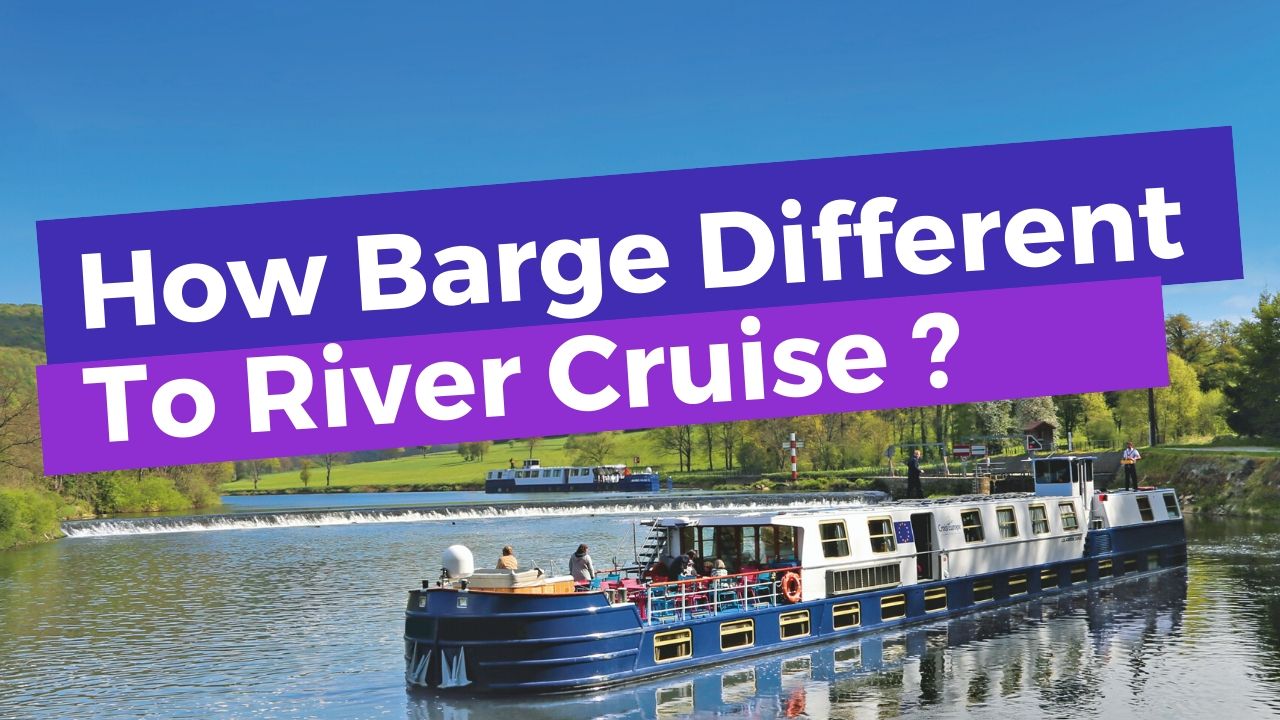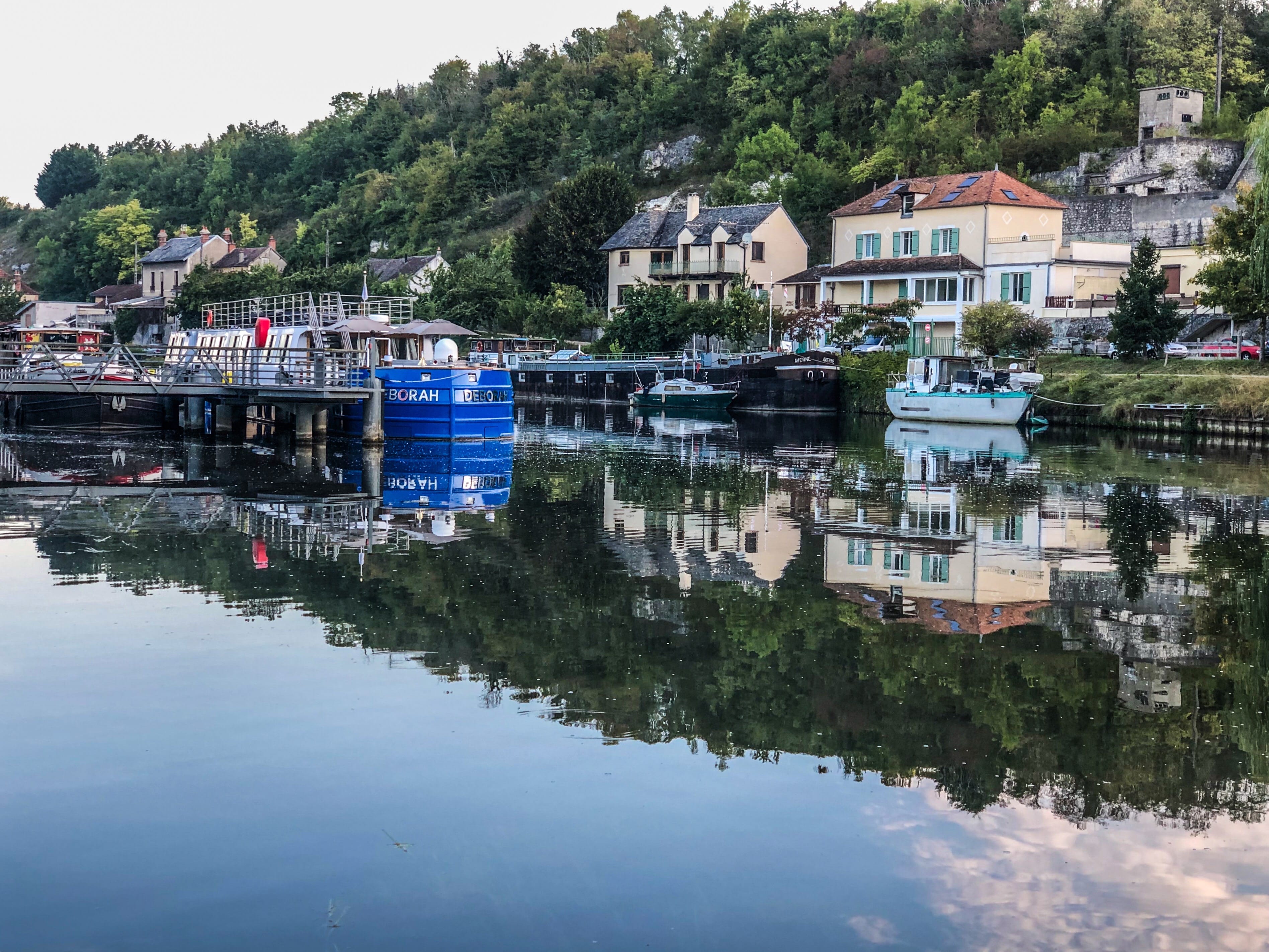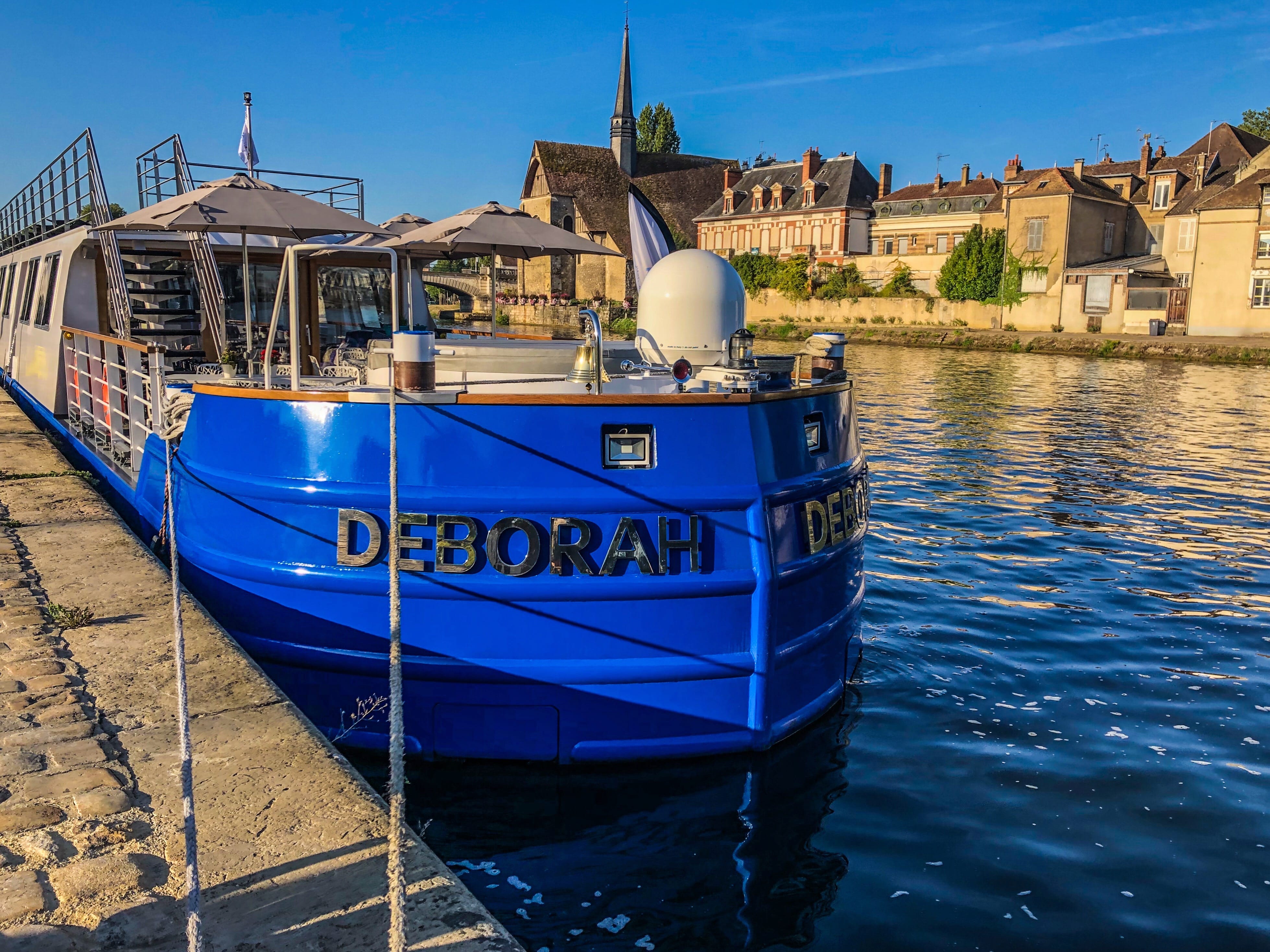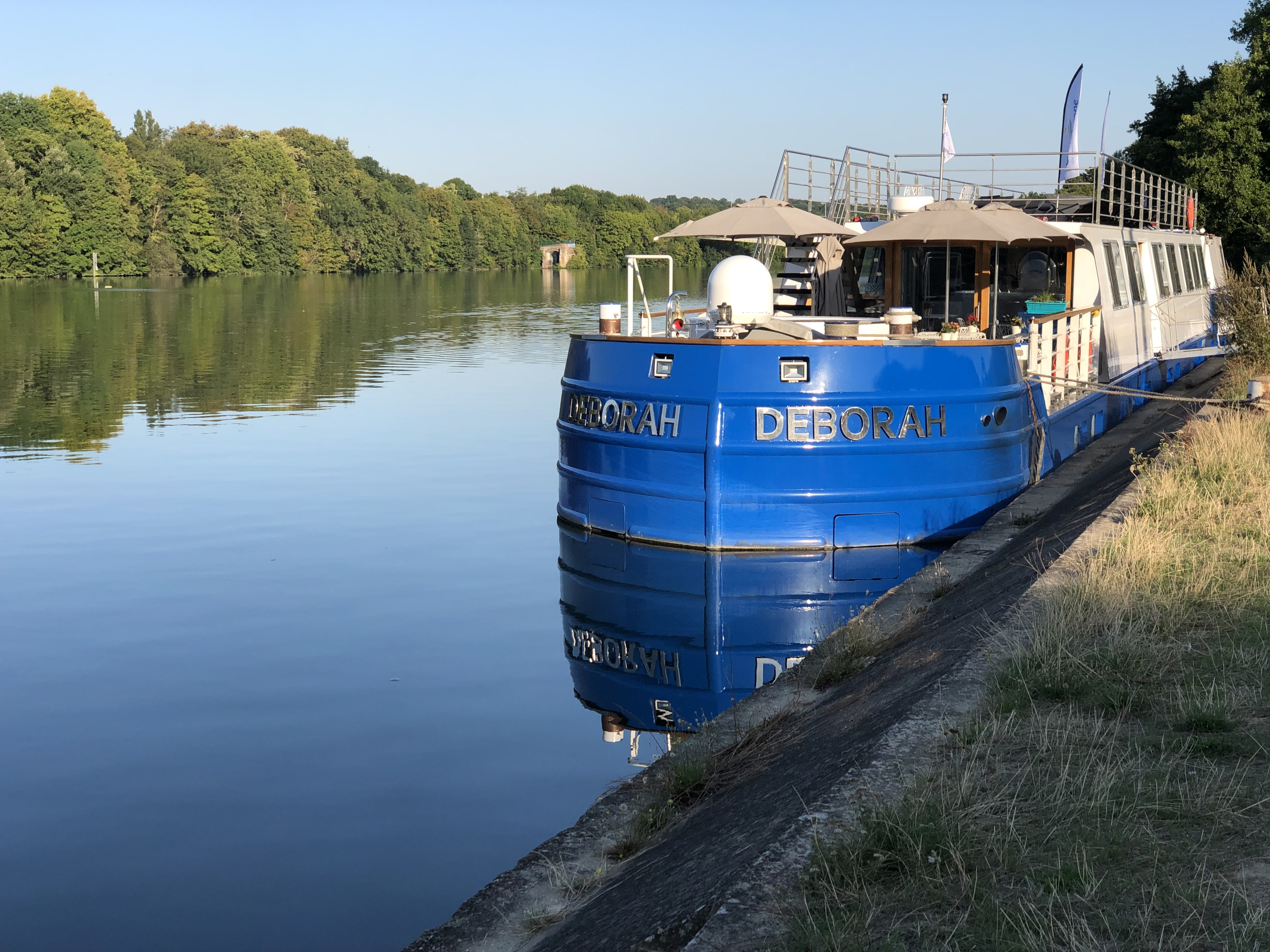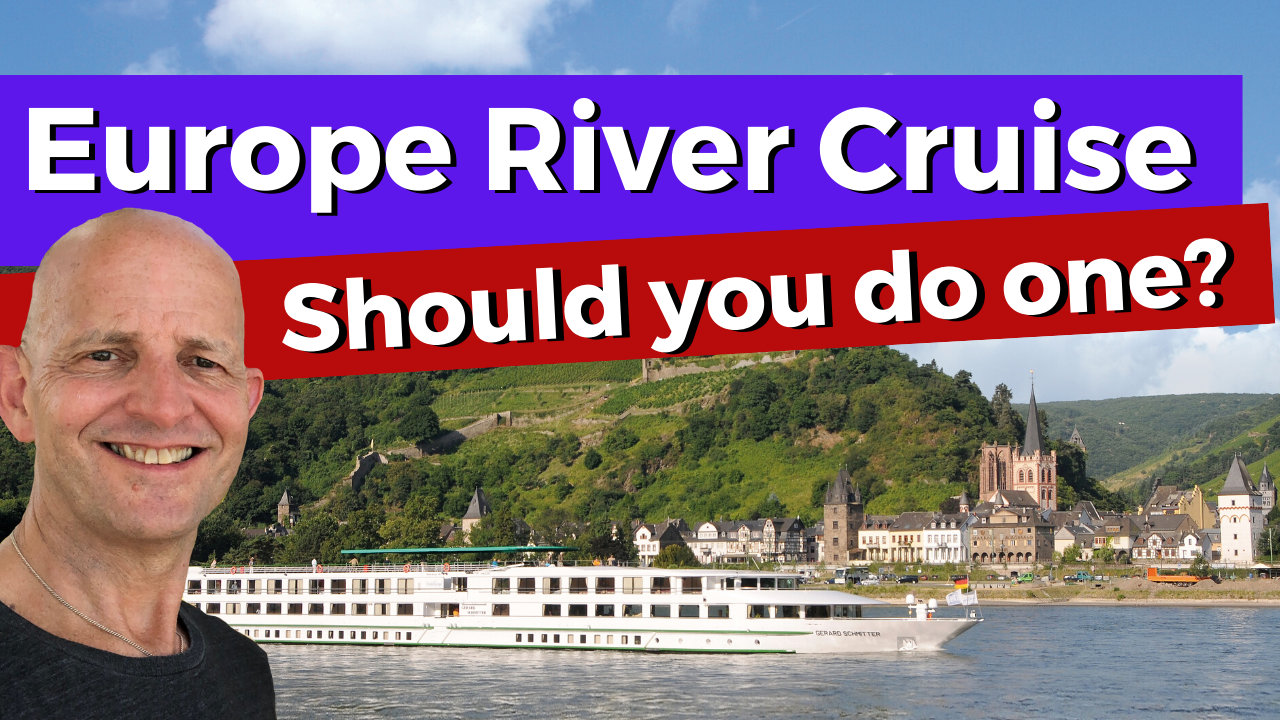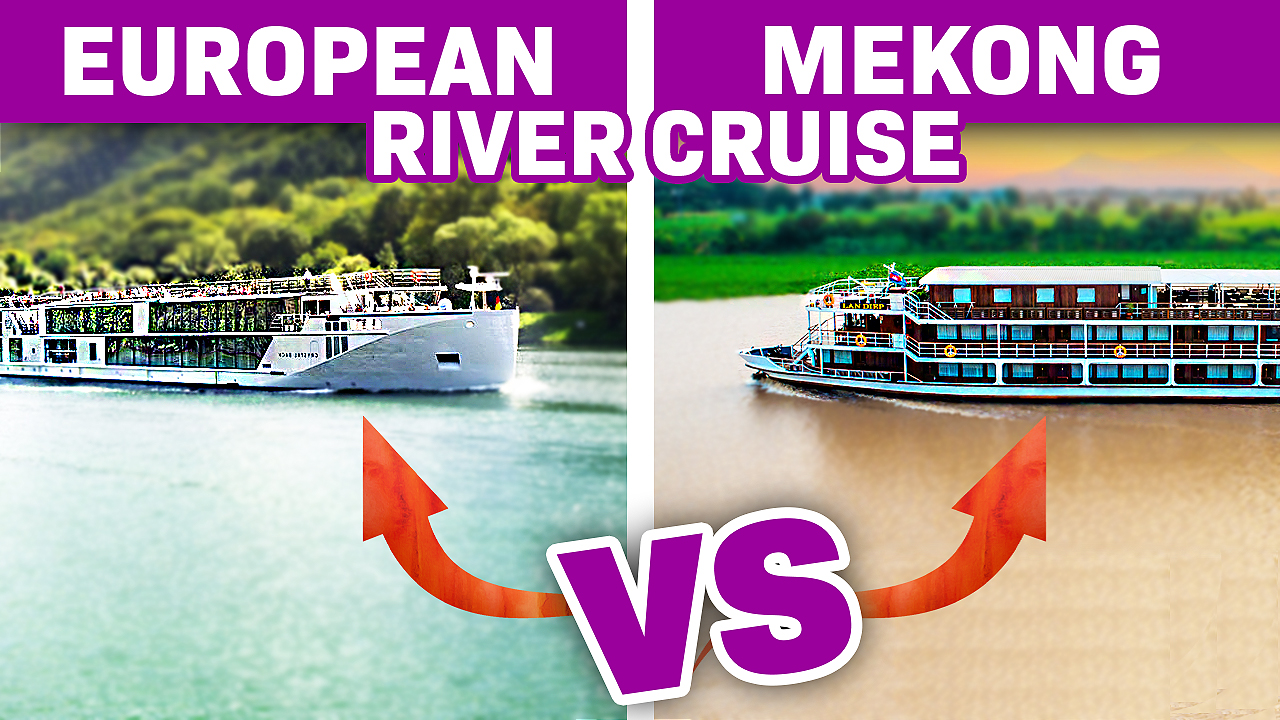Differences Between A European River Cruise and A Barge Cruise
7 Key Differences Between A European River Cruise and A Barge Cruise
I’m just back from a barge cruise through the waterways of France. So, I thought it would be a great opportunity to talk about the differences between a river cruise in Europe and a barge cruise through Europe. In this article, I’ll list 7 key differences between the two.
Watch my Barge versus River Cruise Differences
Watch on YouTube: https://youtu.be/iPa6zuVCZvU
#1 Type of waterways
The first key difference is around the type of waterways used for both types of cruise, and the range of options available to you.
River cruises are available on pretty much every good river in Europe (such as well-known rivers like the Rhine, Danube, Moselle, Main, Seine, Po, Rhone, Douro and Elbe). But barges only go where there are canals.
Barge cruises
95% of barge cruises go on man-made canals rather than rivers. These are canals that were built largely in the 18th century. Before railways were widespread, to move goods around the country.
For example, I was on the CroisiEurope Deborah barge on the Yonne and Seine Rivers because the water levels were too low in the canal. CroisiEurope covers French Canals – Alsace, Burgundy, Champagne, Ile de France, Upper Loire and Provence. The one we did was more of a barge river cruise.
Less distance
The barges on canals travel much less distance. So, whilst on a river cruise, you could go through four or five countries and travel hundreds of miles, a barge is very different. It will only travel around 50 to 70 miles per week. For example, we did about 76 miles on our trip over six nights. Barges go much slower, and cover much less ground. Unlike a river cruise where you can go through multiple countries in the space of a week.
The range of places you can go to on a barge is much more limited than on a river cruise. For example, there’s a lot of barges in France, as well as England, Scotland and Ireland. You’ll also find more limited ones in other parts of Europe, like Holland and Belgium. Hotel barge season is from April until October, which is the same for river cruises.
#2 Amount of choice
The second key difference between a barge and a river cruise in Europe is the amount of options and choices. On a river cruise you have a huge amount of cruise lines, ranging from very premium to more value price points.
There’s a huge number of rivers you can choose from, and there are loads of permutations of itineraries. However, when it comes to barges, you’re going to have much less choice. There are very few operators of barge cruises in Europe.
I went on CroisiEurope, and there’s probably only two or three other real players if you want to go on a barge cruise.
A river cruise offers you a huge option of different lines; lots of different rivers, lots of different itineraries and multiple countries you can go to. If you choose to go on a barge cruise, you’re going to have much less choice of both lines and countries that you can go to on a barge cruise versus a river.
#3 The pace of cruising
The third, and probably one of the biggest differences between a river and a barge cruise in Europe is the pace of travel. A river cruise can be pretty frantic, and certainly one thing I discovered when I started river cruising is it’s a much more ‘full-on’ trip.
You get up early, you have breakfast, you go on your excursion, then you might cruise a little bit and then they’ll have another excursion, then dinner, some entertainment and a have briefing, and it is all pretty full on in terms of the schedule. You also have a choice of which tours you want to do.
Different pace
However, a barge cruise operates at a completely different pace, and that’s for a couple of reasons. First of all, the barges go much slower (4mph) and cover much less distance, and importantly barges do not cruise at night – only during daylight hours.
So, what normally happens is you’ll have half a day of excursions and half a day of cruising, and then you’ll be docked somewhere at night. So, straightaway the whole pace slows down, because half of the day you’ll be just relaxing on the barge, sailing through the landscape that you’re going through.
#4 Size of the ship
The next obvious difference is the size. A river cruise can hold between 120 to 200 guests and have up to 40 crew staff.
Barges are much smaller. For the Deborah barge that I was on, there was a maximum of 22 guests so it’s dramatically smaller. There’s six crew on board: the captain, a sort of first mate who helps the captain, a cruise director, waitress, a chef and a housekeeper. The crew: passenger ratio is very high on a barge.
Less facilities
As the ship itself is much smaller, you obviously have less facilities than you would have even on a river cruise, which again is pretty limited. On the barge, you normally have cabins on the lower level; ten of the eleven cabins on Deborah were on the lower level. On the main level you have a dining room, a seating area sort of a lounge, (which has a little bar) then outside you have an open deck, which on Deborah had a hot tub as many of the barges do.
There is also an upper level, although often the upper level is closed when cruising along canals as the bridges tend to be pretty low. The facilities are much less on a barge, and you’re not going to have a choice of dining, a fitness centre or a spa.
No pools
Some river cruise ships even have swimming pools, but you’re not going to find any of that on a barge. Not surprisingly, because of the nature of the waterways that barges cruise on. It’s a much smaller vessel.
Barge tours and excursions are a bit more limited compared to river cruises, but they do happen. For example, you’re likely to do town walking tours and visits to cathedrals, Castles, and chateaus, or go to a local food market.
#5 The cabins
The next key difference is linked to that – the cabins themselves. On a river cruise, many ships give you a huge choice including suites and balcony cabins. And then you can have cabins which you only have water views, which normally tend to be slightly below the water level.
River cruise cabins
You have a wide range of cabins and while the cabins on river cruise boats are still quite small, they’re also quite spacious. They will range in size, from a tight 135 square feet to suites that are 300 square feet or larger, on a luxury river cruise.
Barge cruise cabins
However, on a barge, your bedroom is just a place to sleep and get ready. The cabins are pretty small. So, again, we’ll just take an example of the one I had on Deborah, where there were two single beds, lots of storage space (very cleverly put in above the bed), a little seating area with a dressing table area, and a bathroom. The bathroom was a shower room.
The cabins on a barge are not places that you’re really going to want to spend a lot of time in. That’s important because you spend half the day cruising and the cabins themselves about 2/3 or 3/4 of them, are below the water level. When you are cruising along, they can be relatively noisy (in my view).
So, cabins that you might want to relax and spend time in can be found on a river cruise, but on a barge it’s simply a practical space for sleep and dressing.
#6 Food and drink
The next key difference is around food and drink.
On river cruises you have incredible food with large menus and on some, you have a choice of dining venues with lots of choice. There’s usually a main restaurant that serves three meals a day. The morning and lunch menus are often a mix of buffet and made-to-order items. While dinner is a three-four- or five-course served meal, with several options for appetisers, entrees and desserts.
Many river cruise ships now have a secondary restaurant that either does a special fixed menu – often with paired wines – or a more casual bistro. Where passengers can come and go. Almost all menus are a mix of regional and familiar dishes.
Barge dining
It’s different on a barge cruise. The food on a barge cruise is impressive and gourmet like, the meals are big and long and really they do go to town!
I’ll share an example of what we had on the CroisiEurope Deborah, which is pretty typical of other barge cruises that you could go on. Breakfast would be the most informal of all the meals and that would be a buffet breakfast: pastries, cereal, yogurt, fruit and that kind of thing, as well as an egg of the day – like scrambled eggs one day, omelette the next.
Lunch
Lunch was probably the main meal of the day, and it was a big deal. It would be a four-course meal: a starter, main course and then, (being France) you’d have a cheese course. Every day, two different cheeses were introduced, and we’d be told the story of the cheese(!) and then there’d be a dessert.
Evening meal
In the evening on the barge, there would be a three-course meal: starter, main course and dessert. One important thing to note is that this is a set menu. There are not choices. If you have dietary issues, like you’re vegetarian, vegan, gluten-free or have any allergies, it’s very important when you make the booking to work with the company you’re going with to ensure that they know your dietary requirements. Also, when you get on board, make sure that the chef knows.
The chef can be pretty flexible because they do buy a lot of stuff along the way, but you’re not going to have a huge choice of what to eat. On river cruises you’ll have choices of starters, main courses and desserts. Normally, that’s not the case on a barge cruise. However, on both the food quality is very high, and on a barge, all of your drinks are included on a barge cruise.
#7 Fares
The next key difference is around fares. River cruise and barge fares are largely all-inclusive, and the price point is a lot higher than what you’d pay for most ocean sailings. On river cruise lines it differs a little bit in terms of what is and isn’t included.
Let’s look at barges. If I take the example again of the cruise I was on, transfers to and from Paris were included. On barge cruises transfers are normally included, as well as your accommodation, food and drink, Wi-Fi, and excursions.
Depending on the cruise line you’re on, gratuities are either included or not included. On CroisiEurope Deborah gratuities weren’t included, so that was my only expense – everything else was included.
Summary
My first barge cruise was a great experience, and the differences that I found were quite intriguing between that and river cruising.
I love them both. River cruising is fantastic and definitely barge cruising is fantastic. I hope you found those differences between river and barge cruising helpful and interesting!
View more of my cruising tips.
SUPPORT TIPS FOR TRAVELLERS
- Find out about being a YouTube Channel Member: https://www.tipsfortravellers.com/Join
- Find out about being a Patron on Patreon: https://www.patreon.com/tipsfortravellers
- Check out my T-Shirt range: http://bit.ly/TFTStore
FOLLOW ME ON SOCIAL MEDIA
——————————————-
- YouTube: http://www.youtube.com/tipsfortravellers
- Twitter: http://www.twitter.com/garybembridge
- Facebook: http://www.facebook.com/tipsfortravellers
- Instagram: http://www.instgram.com/garybembridge
- LinkedIn: https://www.linkedin.com/in/bembridge
- TikTok: @garybembridge

